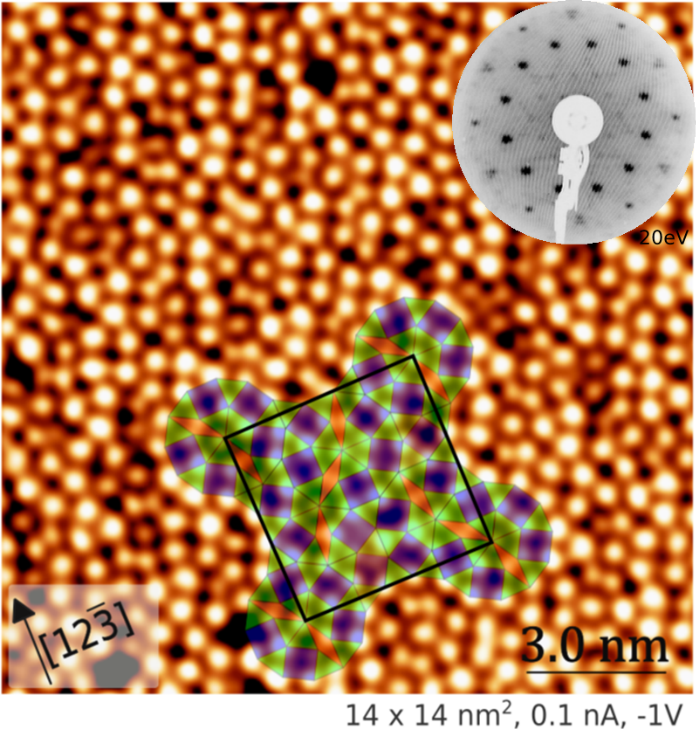[New two-dimensional oxides] New quasicrystalline approximant phases in two-dimensional oxides formed from SrTiO3/Pt(111)/Al2O3(0001) heterostructures
New two-dimensional (2D) oxide phases have been synthesized at IJL from SrTiO3/Pt(111)/Al2O3(0001) heterostructures fabricated on the D.A.U.M. platform. These ultra-thin films stacking were then reduced by heat treatments under ultra-high vacuum in order to form 2D oxides with new structures, with no equivalent in the bulk.
The films were characterized at the atomic scale by surface science methods. Their atomic and electronic structures have been modeled by calculations based on the density functional theory performed at the EXPLOR high performance computing center and at national centers (GENCI, TGCC, IDRIS). These 2D oxides present a rather strong adhesion with the metal substrate due to interactions combining hybridization between electronic states and charge transfer from the oxide layer to the substrate
Quasicrystals are long-range ordered materials but they do not possess the translation periodicity of usual crystals. As a result, they can exhibit forbidden symmetries such as 5-, 8-, 10- or 12-fold rotational symmetries. First discovered in intermetallics, quasiperiodic structures they have also been identified in soft matter (colloids, smectic phases) and, more recently, in low-dimensional oxides.
The new phases that have been discovered at IJL are approximant phases, i.e. periodic phases with large unit cell and exhibiting a local order similar to that of the corresponding quasicrystalline phase. They were obtained by reduction of SrTiO3/Pt(111)/Al2O3(0001) heterostructures. The crystalline structure of these 2D phases can be described by specific tilings using a few elementary tiles (squares, triangles and rhombuses) as observed by STM.
A model of the chemical decoration of the tiles is proposed and theoretical calculations using the density functional theory have been carried out. They point the exothermic formation of these systems, which interact quite strongly with the underlying metal support, but weakly than less complex structures.
The optimization of the atomic positions shows a significant relaxation in the direction perpendicular to the surface, which could alleviate the strain due to the lattice mismatch between the substrate and the oxide layer. The interaction between the film and the underling metal is ensured by hybridization of electronic states and by charge transfer from the oxide layer to the underlying metal.
The calculated STM images are in perfect agreement with the experimental images, which confirm both the atomic structure model and the two-dimensional character of the oxide formed. Compared to the initial perovskite structure, the 2D oxide films obtained after reduction are under stoichiometric both in oxygen and in strontium.
This work is the result of a collaboration between three IJL groups (Metallurgy and Surfaces ; Spintronics and Nanomagnetism ; Surfaces, Spectroscopies and Modeling) and Its D.A.U.M. technical platform.

Reference:
Title: Two-dimensional square and hexagonal oxide quasicrystal approximants in SrTiO3 films grown on Pt(111)/Al2O3(0001).
Authors: C. Ruano Merchan, T. T. Dorini, F. Brix, L. Pasquier, M. Jullien, D. Pierre,
S. Andrieu, K. Dumesnil, S. S. Parapari, S. Šturm, J. Ledieu, M. Sicot, O. Copie, E. Gaudry and V. Fournée.
Journal: Physical Chemistry Chemical Physics
Date of publication (online): Mars 2022
Link: https://doi.org/10.1039/d1cp05296a
Image caption: STM image and LEED pattern of a 2D quasicrystalline approximant with a giant square unit cell revealing a structure with pseudo-dodecagonal symmetry.
Right: Theoretical model of this approximant and chemical decoration of the elementary tiles. The lattice parameter of the square lattice is 44.4 Å.

